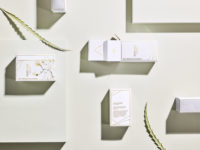How to Create Sustainable Packaging for Luxury Brands
Marrying Luxury with Sustainability

Sustainable luxury in packaging may seem like an oxymoron, but in today’s consumer-driven marketplace it is becoming a vital component of a brand’s image. Consumers are more aware than ever before of the impact that packaging has on our environment. As a result, seemingly every supplier that contributes solutions to the luxury packaging industry has its own spin on what the concept of sustainable luxury means. For designers, it requires extraordinary creativity to consider and implement effective design for luxury brands while responsibly addressing the world’s need for more sustainable solutions.
A sustainable, luxury package is one that provides the consumer with a sense of comfort, ease or pleasing excess by looking at, touching and opening packaging that was manufactured using materials and processes that do not excessively deplete or completely destroy natural resources.
Consumer confusion is understandable with the many options offered by packaging providers. Some of these include packaging that incorporates non-renewable materials and/or processes while focusing on circular solutions such as recyclability, reusability, etc. While these extend the availability of the materials’ resource, these will ultimately result in the depletion or even destruction of the natural resource. Furthermore, recycling is only a sustainability attribute if the service is available in the location where the product’s package is disposed of in addition to the consumer’s behavior. We can see the devastation of these materials as they inadvertently accumulate and wreak havoc on our environment.
Other options include renewable packaging material resources such as plant-based fibers. Packages made from these materials also comply with sustainable processes such as recycling and compostability. Metals and glass are also options, but the renewability and lighter weight of plant-based fibers makes them exceptionally appealing for packaging applications.
Many luxury brands today understand the need for sustainability in the process. As leaders of their industries they have a responsibility to protect the health and wellbeing of the environment and the people who live in it. What they have not discovered is how to do it while maintaining their consumers’ perception of luxury.
So what can we as designers do to help create more sustainable luxury for these high-end brands?
Here are a few examples where a little excess in the packaging is done in a more responsible way.

A giftset box is typically used to showcase skincare, perfume, lotions and other beauty care items. Upon first glance it appears to be a standard, rigid-box giftset, however this is no ordinary rigid box. This package has been created by wrapping a chipboard or corrugated inner core with a fresh fiber, folding boxboard outer without the use of glue. Recycled chipboard is used for a more luxurious, heavier feel for the box while corrugated materials provide a lighter-weight package. Best of all, the window allowing the consumer to peer into the package is designed to be easily removed by the consumer in order to encourage recycling.

This second solution goes beyond the traditional to express the luxurious nature of the brand. Using the most recent advancements in fresh fiber molding and forming technologies, we can design more sustainable luxury inherent in the rounded corners for a giftset. Fiber forming has come a long way since its first introduction into the packaging industry in the form of egg crates and drink cup holders, and it now rivals molded plastics in form, function and aesthetics while being completely compostable and recyclable.
With the enormous increase in e-commerce, more and more luxury brand packaging is finding its way to the consumer via very non-luxurious shipping boxes. What is inside of the shipping box is typically the same package that was created and designed to function in the boutique, the kiosk or the store shelf. It is sometimes packed with paper stuffed into the dead space of the shipping carton or secured with air pillows or bubble wrap—and sometimes it is just a box sliding around the inside of another box. Overall, the experience is anything but a luxurious one. More often than not, a consumer’s first concern is to examine the product to see if the purchase survived the shipping process without damage. It doesn’t get much worse than that for a luxury brand.
Brands—especially luxury brands—want to ensure that the experience and loyalty of the consumer remains intact during the e-commerce distribution chain, and they often struggle with changing their traditional packaging to accommodate the requirements that shipping can necessitate. A sustainable approach to creating a new luxury experience is to design shipping containers that create a new level of consumer experience.

In this third example, the original retail package is eliminated, and the product is presented to the consumer through the shipping container itself by pulling a tab that raises the product out of its protective enclosure.
Our world is changing at a continually faster rate—driven by the megabits and gigabits per second that our information travels from its source to its readers. Now the readers have the ability to share meaningful experiences just as quickly with social media. As our population is inundated with information, more and more consumers are beginning to take sustainability seriously when making purchases. They can see the effects that non-sustainable products have on our world. This consideration is now encroaching on the most luxurious of brands while creating exciting opportunities for designers. It is now our job to make everyone understand that sustainable luxury doesn’t have to be an oxymoronic packaging trend…it can simply become a new definition of luxury.
Looking for a reprint of this article?
From high-res PDFs to custom plaques, order your copy today!





